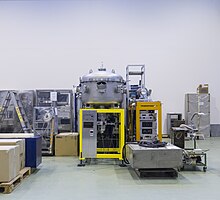SEC experiment
| List of ISOLDE experimental setups | |
|---|---|
| COLLAPS, CRIS, EC-SLI, IDS, ISS, ISOLTRAP, LUCRECIA, Miniball, MIRACLS, SEC, VITO, WISArD | |
| Other facilities | |
| MEDICIS | Medical Isotopes Collected from ISOLDE |
| 508 | Solid State Physics Laboratory |

The Scattering Experiments Chamber (SEC) experiment is a permanent experimental setup located in the ISOLDE facility at CERN. The station facilitates diversified reaction experiments, especially for studying low-lying resonances in light atomic nuclei via transfer reactions.[1] SEC does not detect gamma radiation, and therefore is complementary to the ISOLDE Solenoidal Spectrometer (ISS) and Miniball experiments.[2]
Experimental setup
[edit]The SEC experiment uses radioactive ion beams from ISOLDE, at the end of XT03 beamline of the HIE-ISOLDE facility.[3] The ion beam first passes through a collimator, of 15 mm aperture, surrounded by 4 silicon detectors, designed for beam optimisation.[4]
The SEC chamber has a diameter of 1 m and height of 50 cm, with the reaction target placed in the centre on a motorised target holder. The target holder has the space for four targets, and each target can be moved in place via remote control. The reaction target is surrounded by double-sided silicon strip detectors (DSSSD) which are positioned so that the angular coverage is optimised, depending on the experiment.[5] DSSSDs allow for efficient detection of all emitted particles in the reaction.[6] The main support for the detector is a circular movable table which has radially arranged holes at the centre.[4]

GLORIA
[edit]GLORIA (GLObal ReactIon Array) is a configuration used in SEC to measure fragments produced in reactions. It consists of six silicon telescopes, which surround a certain scattering angle of the reaction target (from 15° to 160°.[7][8] GLORIA was designed to have a compact geometry with the ability to resolve mass and ion charge up to carbon isotopes, due to the two-stage DSSD telescopes.[8]
SAND
[edit]The SAND array is used at the scattering chamber SEC, for the detection of charged particles and neutrons.[9] The array consists of 30 modules, each being a plastic scintillator with fast photomultiplier tubes. The array can be moved to bring it closer to the target.[10]
External links
[edit]References
[edit]- ^ "SEC | ISOLDE". isolde.cern. Retrieved 2023-08-03.
- ^ Martel, I; Tengblad, O; Cederkall, J (29 Apr 2019). "Physics at ISOLDE with SEC" (PDF). indico.cern. Retrieved 3 Aug 2023.
- ^ Sparta, Roberta; Figuera, P.; Pietro, A. di; Tengblad, Olof; Fernández-García, J. P.; Acosta-Sánchez, Luis Armando; Bjorn, Jonson; García Borge, María José; Bruni, Giovanni; Davison, Thomas; Ovejas, J. D.; Fraile, Luis M.; Galaviz, D.; Halkjaer Jensen, Jesper; La Cognata, Marco (2019-12-05). "Elastic scattering of p-halo 8B beam close to the Coulomb barrier". Comunicaciones Congresos.
- ^ a b "S E C : Scattering Experiments Chamber at XT03 HIE-ISOLDE". isolde-sec.web.cern.ch. Retrieved 2023-08-14.
- ^ Kundalia, K.; Gupta, D.; Ali, Sk M.; Saha, Swapan K.; Tengblad, O.; Ovejas, J. D.; Perea, A.; Martel, I.; Cederkall, J.; Park, J.; Szwec, S.; Moro, A. M. (2022-10-10). "Study of elastic and inelastic scattering of 7Be + 12C at 35 MeV". Physics Letters B. 833: 137294. arXiv:2207.10865. doi:10.1016/j.physletb.2022.137294. ISSN 0370-2693.
- ^ Fynbo, H. O. U.; Diget, C. Aa.; Prezado, Y.; Äystö, J.; Bergmann, U. C.; Cederkäll, J.; Dendooven, P.; Fraile, L. M.; Franchoo, S.; Fulton, B. R.; Huang, W.; Huikari, J.; Jeppesen, H.; Jokinen, A.; Jonson, B. (2004-06-28). "News on 12C from β-decay studies". Nuclear Physics A. Proceedings of the 8th International Conference on Clustering Aspects of Nuclear Structure and Dynamics. 738: 59–65. doi:10.1016/j.nuclphysa.2004.04.012. ISSN 0375-9474.
- ^ Ovejas, J.D.; Knyazev, A.; Martel, I.; Tengblad, O.; Borge, M.J.G.; Cederkäll, J.; Keeley, N.; Rusek, K.; García-Ramos, C.; Acosta, L.A.; Arokiaraj, A.A.; Babo, M.; Cap, T.; Ceylan, N.; de Angelis, G. (2020). "Halo Effects in the Low-energy Scattering of \(^{15}\)C with Heavy Targets". Acta Physica Polonica B. 51 (3): 731. doi:10.5506/APhysPolB.51.731. hdl:10272/18868. ISSN 0587-4254.
- ^ a b Marquínez-Durán, G.; Acosta, L.; Berjillos, R.; Dueñas, J. A.; Labrador, J. A.; Rusek, K.; Sánchez-Benítez, A. M.; Martel, I. (2014-08-11). "GLORIA: A compact detector system for studying heavy ion reactions using radioactive beams". Nuclear Instruments and Methods in Physics Research Section A: Accelerators, Spectrometers, Detectors and Associated Equipment. 755: 69–77. Bibcode:2014NIMPA.755...69M. doi:10.1016/j.nima.2014.04.002. hdl:10261/288100. ISSN 0168-9002.
- ^ Gupta, D; Kundalia, K; Ali, Sk M; Maity, S; Mitra, R; Saha, Swapan K; Tengblad, O; Tavora, V G; Perea, A; Borge, M J G; Martel, I; Cederkall, J; Chishti, M; Park, J; Moro, A M (26 Sep 2022). "Breakup of 9Li to study the 8Li(n,γ) reaction" (PDF). Proposal to the ISOLDE and Neutron Time-of-Flight Committee.
- ^ Borge, M J G; Briz, J A; Cederkall, J; De Angelis, G; Figuera, P P; Fraile, L M; Fynbo, H O U; Gad, A; Heinz, A; Holl, M; Jensen, E; Johansen, J G; Johansson, H T; Jonson, B; et al. (6 Jan 2021). "Reaction studies with neutron-rich light nuclei at the upgraded SEC Device" (PDF). Proposal to the ISOLDE and Neutron Time-of-Flight Committee.
